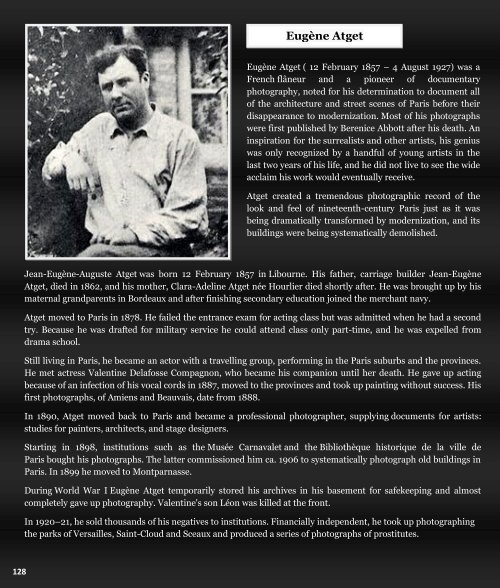Iglobalphotographer magazine edition 1
Create successful ePaper yourself
Turn your PDF publications into a flip-book with our unique Google optimized e-Paper software.
Eugène Atget<br />
Eugène Atget ( 12 February 1857 – 4 August 1927) was a<br />
French flâneur and a pioneer of documentary<br />
photography, noted for his determination to document all<br />
of the architecture and street scenes of Paris before their<br />
disappearance to modernization. Most of his photographs<br />
were first published by Berenice Abbott after his death. An<br />
inspiration for the surrealists and other artists, his genius<br />
was only recognized by a handful of young artists in the<br />
last two years of his life, and he did not live to see the wide<br />
acclaim his work would eventually receive.<br />
Atget created a tremendous photographic record of the<br />
look and feel of nineteenth-century Paris just as it was<br />
being dramatically transformed by modernization, and its<br />
buildings were being systematically demolished.<br />
Jean-Eugène-Auguste Atget was born 12 February 1857 in Libourne. His father, carriage builder Jean-Eugène<br />
Atget, died in 1862, and his mother, Clara-Adeline Atget née Hourlier died shortly after. He was brought up by his<br />
maternal grandparents in Bordeaux and after finishing secondary education joined the merchant navy.<br />
Atget moved to Paris in 1878. He failed the entrance exam for acting class but was admitted when he had a second<br />
try. Because he was drafted for military service he could attend class only part-time, and he was expelled from<br />
drama school.<br />
Still living in Paris, he became an actor with a travelling group, performing in the Paris suburbs and the provinces.<br />
He met actress Valentine Delafosse Compagnon, who became his companion until her death. He gave up acting<br />
because of an infection of his vocal cords in 1887, moved to the provinces and took up painting without success. His<br />
first photographs, of Amiens and Beauvais, date from 1888.<br />
In 1890, Atget moved back to Paris and became a professional photographer, supplying documents for artists:<br />
studies for painters, architects, and stage designers.<br />
Starting in 1898, institutions such as the Musée Carnavalet and the Bibliothèque historique de la ville de<br />
Paris bought his photographs. The latter commissioned him ca. 1906 to systematically photograph old buildings in<br />
Paris. In 1899 he moved to Montparnasse.<br />
During World War I Eugène Atget temporarily stored his archives in his basement for safekeeping and almost<br />
completely gave up photography. Valentine's son Léon was killed at the front.<br />
In 1920–21, he sold thousands of his negatives to institutions. Financially independent, he took up photographing<br />
the parks of Versailles, Saint-Cloud and Sceaux and produced a series of photographs of prostitutes.<br />
128


